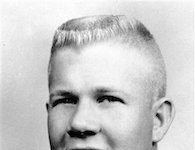On March 18, 1937, the worst school disaster in American history occurred when a gas explosion killed nearly 300 schoolchildren in Texas.
Gas Explosion Destroys Texas School
In the 1930s, while most of the United States was suffering through the Great Depression, the East Texas economy was thriving in the midst of an oil boon. In the East Texas town of New London, oil money funded the construction of modern public school buildings at the cost of $1 million. The consolidated London and New London schools sat on a large campus that included oil derricks and pipelines.
On the afternoon of March 18, 1937, at 3:05 p.m., students at the high school were lining up to board the buses taking them home as a PTA meeting was held at one of the nearby buildings. But then, a spark from the wood shop ignited natural gas that had leaked through the high school, causing an explosion.
“Immediately the building seemed to lift in the air and then smashed to the ground,” describes the Handbook of Texas Online. “Walls collapsed. The roof fell in and buried its victims in a mass of brick, steel, and concrete debris. The explosion was heard four miles away, and it hurled a two-ton concrete slab 200 feet away, where it crushed a car.”
Parents from the PTA meeting and oil workers from the fields rushed to the school and dug through the rubble for survivors. Texas Governor James Allred sent in the Texas Rangers, while workers from the Red Cross, Salvation Army and other organizations also arrived in the town to help.
Related Events
Workers dug through the rubble throughout the rainy night, finding hundreds of small bodies, many of them unidentifiable. Walter Cronkite, who as a young reporter was sent to cover the disaster, recalled, “Grief was everywhere. Almost everyone you ran into had lost a member of his family. Yet they went about doing everything they could to help each other.”
Over the next several weeks, funerals and burials were held for the estimated 298 victims. Ten days after the explosion, school re-opened at a makeshift building; of the 600 students who were in the school prior to the explosion, just 287 were able to attend.
A March 20, 1937, newsreel features video of the relief effort.
Sources in this Story
- The Handbook of Texas: New London School Explosion
- Dallas Observer: “Today, a Generation Died.”
- Los Angeles Times (UPI): 1937 Schoolhouse Explosion ‘Scars Your Mind’
- FreeLibrary.com: Pipeline & Gas Journal: Odorization: simply a matter of safety (PDF)
What Caused the Explosion?
In January 1937, the high school began tapping into a natural gas line on the oil field near the school. Though the school saved $300 a month on its gas bill, the gas it received—known as “wet” gas or “green” gas—was of low quality and had no odor.
On the afternoon of March 18, 1937, there was a leak in the gas line, the cause of which is not known. In 1961, former student William Benson, a convicted burglar, admitted that he had damaged the line because he was upset over being scolded for smoking. However, he retracted his story days later.
At about 3:05 p.m., as odorless gas filled the high school, shop teacher Lemmie Butler turned on a sander, creating a spark that ignited the gas. Butler, like everybody else in the school, was unaware of the gas leak because there was no odor.
In the aftermath of the explosion, the state government passed legislation requiring the chemical mercaptan to be mixed into natural gas so that it could be detected by smell. Similar legislation was later be passed by the federal government.
This article was originally written by Denis Cummings; it was updated February 1, 2017.











